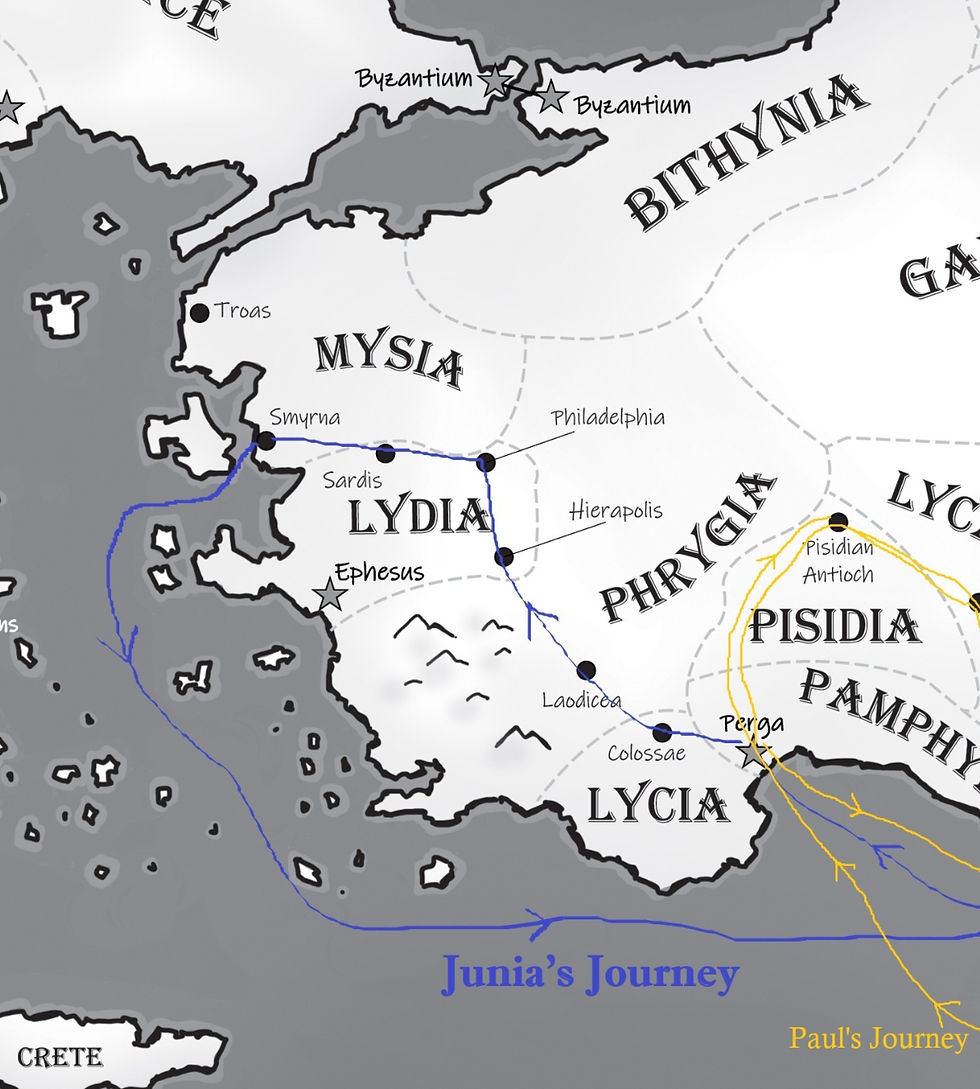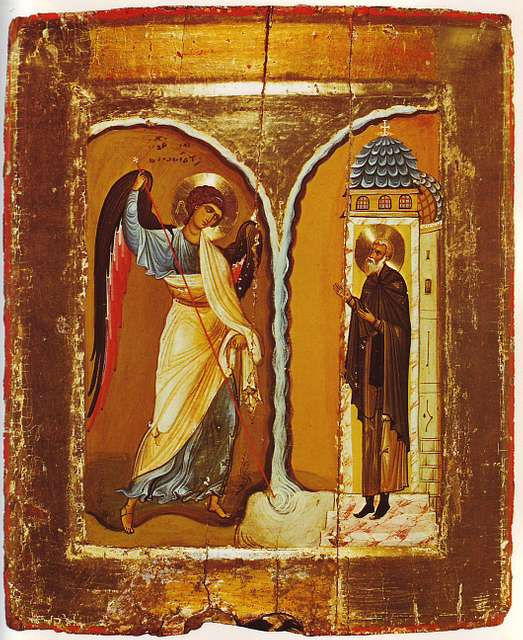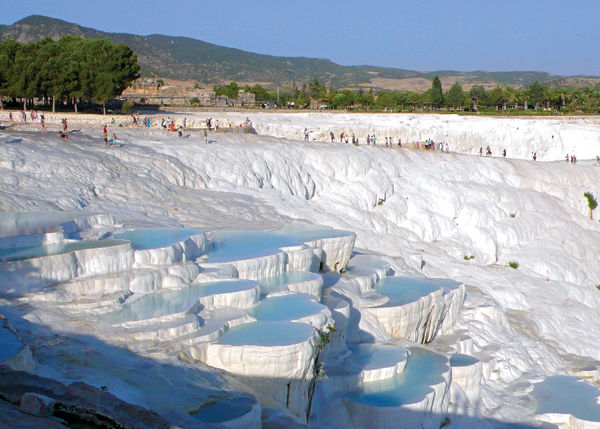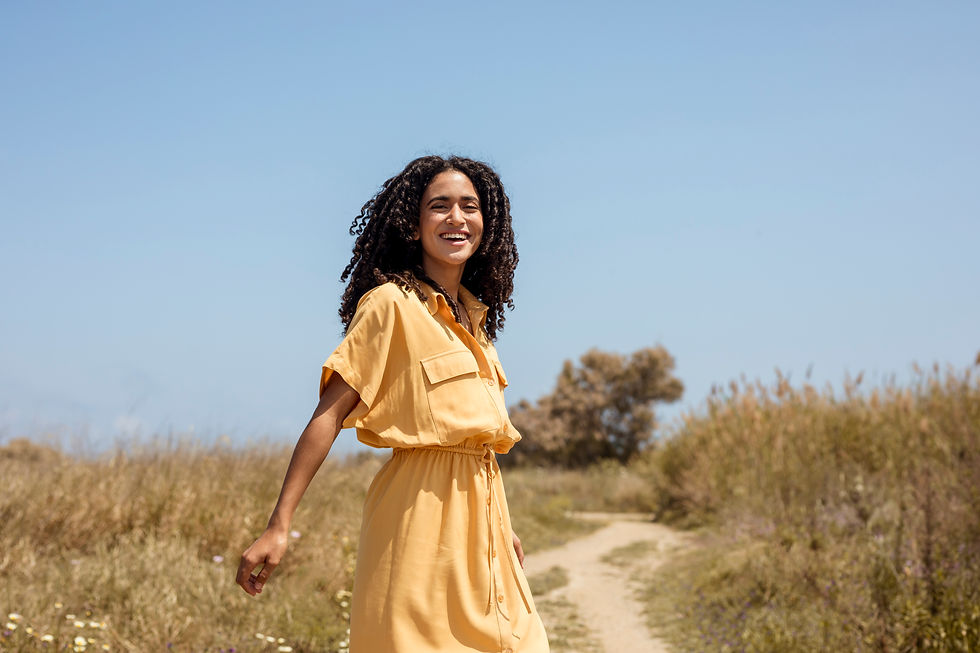Apostle Junia in Colossae, Laodicea, Hierapolis
- Elaine R Kelly

- Jul 23
- 13 min read
Updated: Sep 16
My upcoming historical fiction imagines the backstory of Junia, a woman in the Bible who is called an outstanding apostle. This series of articles describes some of the cities and people she visits in the fictional first mission journey Junia takes in my novel, Finding Her Voice from Broken to Bold: A Novel of Early Female Apostles.
Articles about Junia
Apostle Junia: Who Is She? Paul's description of Junia in Romans 16:7: Paul greets Junia as a female who Paul says was Paul's kindred, fellow captive, in Christ before Paul, and outstanding among the apostles.
Apostle Junia: Making Disciples with a hammer or a carrot?
Apostle Junia in Syrian Antioch: meeting Andronicus and beginning her ministry
Apostle Junia in Colossae, Laodicea, Hierapolis
Apostle Junia in Philadelphia, Sardis, and Smyrna

Junia's Fictional First Missionary Journey:
Following the cities Junia may have visited on these major trade routes, I imagine her first mission journey goes from Syrian Antioch to Perga, Colossae, Laodicea, Hierapolis, Philadelphia, Sardis, and Smyrna. Four of these are cities with churches mentioned in the book of Revelation.
Where were the seven churches in Revelation?

Laodicea (Revelation 3:14-22): called lukewarm; worldly wealthy, spiritually poor
Philadelphia, now Alaşehir (Revelation 3:7-13): steadfast, faithful, enduring
Sardis (Revelation 3:1-6): spiritually dead, while having a reputation for being alive/a city that never sleeps
Smyrna (Revelation 2:8–11): has a great harbour; prophesied to suffer persecution
Three not on Junia's fictional journey:
Thyatria (Revelation 2:18-29): known for its dyer, tanner, and bronze trade guilds. Lydia is from Thyatira (Acts 16:14).
Pergamon (Revelation 2:12-17): told to repent from allowing false teachings
Ephesus (Revelation 2:1-7): faithful.
Colossae
The Place
Colossae was at the base of Mount Cadmus, near the source of the Lycus River in Phrygia, a province in Asia Minor. Read my Bible Study of Colossians here.

Religion in Colossae
Archippus was part of the "Colossian heresy" [1], a blended belief system of Christianity (Archippus taught about Christ), of honouring the God of Israel (Archippus obeyed Jewish food laws), worship of Apollo (Archippus started serving in the temple at age ten), belief in angels, and asceticism (often celibacy).
Miracle in Colossae
Records from church, history, and geology come together in a traditional story of the Archangel Michael appearing to Archippus at Colossae (also called Chonae) and performing a miracle.
In the first century, Archippus was in the church praying because two mountain streams were combining and threatening to flood the church and the town. The Archangel Michael opened a fissure in the rock, diverted the waters to go to a new underground canyon, and saved the people [2]. Scientists confirm that in the first century, the Lycus River went underground at Colossae and reappeared about 900 meters later. There was a large earthquake in about AD 60 that damaged Colossae, Hierapolis, and Laodicea, and the city of Colossae never recovered.
The People of Colossae
This novel takes place in the late AD 40s, possibly twenty years before Paul wrote his letters to Colossae and Philemon.
Epaphras (Colossians 1:7-8; 4:12-13) "our dear fellow servant"; Colossians learned the good news from Epaphras, who is "one of you" and a "servant of Christ Jesus". He is working hard for those in Colossae, Laodicea, and Hierapolis. Epaphras is apparently in Rome with Paul when Paul writes the letter to the Colossians and to Philemon in the late AD 50s. While some people of Colossae may have heard about Jesus from Epaphras, it is also possible that Junia brought the good news, and then Epaphras, Apphia, and Archippus, who were residents of Colossae, organized the continued teachings.
Philemon (Philemon 1:1): our dear friend and fellow worker, a wealthy slave-owner; may have come to the faith later than Apphia.
Apphia (Philemon 1:2). Paul calls Apphia “our sister,” an equivalent title to that he gives Timothy, “our brother.” Paul may be naming her in the letter to ask her to influence Philemon not to punish his runaway slave, Onesimus, but to welcome him as a brother in Christ, Paul’s spiritual child. Traditional views limit Apphia’s influence by suggesting she was simply Philemon’s wife. Sara Winter states that “Apphia is prominent enough to be named among the men without being socially confined as a wife [3].” Theologian Marg Mowczko Apphia may have been a ministry leader, co-worker, patron, and deacon[4]. The Orthodox Church awards Apphia with the title, Equal-to-the-Apostles [5]. This novel imagines Apphia as one of the first Christians in Colossae,
Paul greets the church that meets in “your home,” and it is unclear if that means the home of Apphia, Archippus, or Philemon.
Archippus (Philemon 1:2). "fellow soldier" given a special ministry task; the Lord assigned him a certain service (deacon) that he is hesitant to carry out (Colossians 4:17). Some traditions assume Archippus is Apphia's son [6].
What might Apostle Junia do?
I imagine her describing and offering Jesus's living water.
I imagine her destroying a statue of Apollo and raising opposition from locals.

[3] Nicholas Quient, “Was Apphia an Early Christian Leader?” CBE International, April 30, 2027, https://www.cbeinternational.org/resource/was-apphia-early-christian-leader/.
[4] Marg Mowczko, “Apphia: Philemon’s Wife or Another Phoebe?”, Marg Mowczko, October 29, 2016, https://margmowczko.com/apphia/.
Laodicea

The Place
Laodicea was on the top of a plateau between two rivers that flowed into the Lycus River. It was located just 15 km west of Colossae and 10 km south of Hierapolis. Laodicea was on two major trade routes, stretching west to Sardis on the Adriatic Sea, and east to Syria. Strabo, a first-century geographer in Asia Minor, noted that textiles and its famous black wool were key trade commodities for Laodicea [1]. It had a prosperous banking industry, valuable, unique black wool, and a school of medicine that specialized in eye salves[2].
Laodicea in Revelation: Poor Water, Poor Clothing, Poor Vision
Laodicea was criticized for being lukewarm:
“And to the angel of the church of the Laodiceans write, ‘These things says the Amen, the Faithful and True Witness, the Beginning of the creation of God: “I know your works, that you are neither cold nor hot. I could wish you were cold or hot. So then, because you are lukewarm, and neither cold nor hot, I will vomit you out of My mouth. Because you say, ‘I am rich, have become wealthy, and have need of nothing’—and do not know that you are wretched, miserable, poor, blind, and naked— I counsel you to buy from Me gold refined in the fire, that you may be rich; and white garments, that you may be clothed, that the shame of your nakedness may not be revealed; and anoint your eyes with eye salve, that you may see. As many as I love, I rebuke and chasten. Therefore be zealous and repent. Behold, I stand at the door and knock. If anyone hears My voice and opens the door, I will come in to him and dine with him, and he with Me. To him who overcomes I will grant to sit with Me on My throne, as I also overcame and sat down with My Father on His throne." (Revelation 3:14-22 NKJV) Bold emphasis added.
The church in Laodicea is named in Revelation 1:11 and Revelation 3:14-22. John's Revelation contrasts the high worldly image of the people of Laodicia with their spiritual poverty. John's Revelation criticizes Laodicea:
a) for being neither hot nor cold. The vision does not suggest that hot is good and cold is bad. It suggests it's better to be one or the other. Hierapolis had natural hot springs for healing the body, and Colossae had fresh cold springs for healing the spirit, but Laodicea had neither [3]. Laodicea brought water 8 km through an aqueduct, likely filled with silt and minerals, piping the water up to the plateau of the city. The water would be neither hot nor cold when it arrived, and it would have had neither the benefits of hot nor cold water.
b) for claiming to be rich, since they were a wealthy trading centre and a centre for banking, while they were spiritually poor. It had false gold and needed God's refined gold.
c) for its pride in wearing and trading unique black wool and garments, while spiritually they are naked and need God's white garments to cover their spiritual poverty and nakedness.
d) for claiming to cure poor vision with its famous medical school, using Phrygian powder to make an eye salve. Christ offers an eye salve to heal them of their spiritual blindness.
Religion in Laodicea
Laodicea worshipped both local and Roman gods, including Zeus. It also had a large Jewish population. Some of them likely followed the Colossian heresy, amalgamating Roman and Jewish gods with the worship of Christ.
A map of ancient Laodicea shows several temples, likely to various gods. The Caracella Nymphaeum (Fountain) later became a meeting place for Christians [4]. The people of Laodicea may have honoured the goddess-nymphs of the evening. Called the Hesperides, these nymphs were entrusted with taking care of the golden apples presented to the goddess Hera by Gaia. The nymphs and their golden apples were considered the source of the golden light of sunset [5].
The People of Laodicea
The church has traditionally credited Epaphras for introducing Christianity to Laodicea and called him a disciple of Paul.
Let's look at what we actually know:
Paul did not bring Christianity to Laodicea. Paul apparently never visited Colossae but heard about their faith (Colossians 1:4). Paul asks the Colossians to share his letter with the churches in nearby Laodicea and Hierapolis (Colossians 4:13-16).
Epaphras was a Christian teacher who lived in Colossae, near Laodicea, and told Paul about the faith of the Colossians. It is possible that Epaphras learned about Christ from someone other than Paul and was teaching about Christ before he visited Paul in prison in Rome.
Tychicus delivered Paul's letters to Colossians, Philemon, and Ephesians, likely on the same trip, bringing Onesimus with him (Ephesians 6:21, Colossians 4:7-9, Philemon 1:10-13). He did not stay in these towns.
Nympha lived in Laodicea (Colossians 4:15) and hosted a church in her home in Laodicea. She may have been a house church leader, minister, deacon, and patron, taking care of the well-being of her members [6].
We don't know who initially brought the good news to Laodicea.
Paul heard about the faith of the Colossians but there's no evidence he visited Colossae or Laodicea.
Epaphras was a Christian teacher, but we don't know who initially taught the good news to Epaphras before he visited Paul in Rome and told Rome about the Christians in Colossae.
Tychicus did not initially bring the good news to Laodicea; he went there later to deliver Paul's letter.
What we do know is that it is likely that Nympha was the lead teacher of Christianity in Laodicea.
What is possible is that she received the good news from an early apostle such as Junia.
What might Apostle Junia do?
I imagine her being imprisoned for destroying idols and for criticizing the people for thinking of themselves with worldly wealth while being spiritually bankrupt. She may have talked about how Jesus can heal your vision and let you see as God sees.

[1] Iza, "Laodicea on the Lycus", March 9, 2017, Turkish Archaeological News, https://turkisharchaeonews.net/site/laodicea-lycus
[2] Tom Pennington, “Laodicea: A False Gospel”, Countryside Bible Church, October 10, 2021, https://countrysidebible.org/sermons/20211010p-107281.
[3] "What does the Bible say about Laodicea?" Bible Info, a ministry of Voice of Prophecy. Accessed May 29, 2025 https://www.bibleinfo.com/en/questions/laodicea
[4] "Laodicea Caracalla Nymphaeum", accessed May 29, 2025, https://www.ritmeyer.com/product/image-library/buildings/churches/laodicea-caracalla-nymphaeum-3/
[5] "Hessperides", accessed May 29, 2025, https://www.theoi.com/Titan/Hesperides.html
[6] Marg Mowczko, “Nympha: A House Church Leader in the Lycus Valley (Col. 4:15), Marg Mowczko, September 19, 2018, https://margmowczko.com/nympha-house-church-colossians-415/.
Hierapolis

The Place
Just ten km from Laodicea, the white travertine terraces of Hierapolis are visible even today from the platform of the restored Temple of Athena in Laodicea [1]. Calcium carbonate steam from the hot springs of Hierapolis landed and hardened to form white travertine, called Pamukkale, a sedimentary limestone [2]. It had well-built city walls, temples, a triumphal arch, gymnasium, hot baths, and a theatre. The warm water is useful for medicinal purposes, for dying textiles, as well as being pleasant to taste [3].
Eye disease was common, explaining the medical school specializing in eye salves. Both Stachys and Nicanora are reportedly healed of eye disease. Interestingly, carbon monoxide (CO) can cause blurred vision, light sensitivity, vision loss, and especially the loss of peripheral vision. Vision loss caused by CO poisoning can be reversed by prompt treatment with intense intake of oxygen (today we would use hyperbolic oxygen therapy). It appears the Phrygian stone had properties that counteracted the CO poisoning.
Hierapolis was a great city, with large city walls and gates, a temple to Apollo, a Roman theatre, and a large necropolis outside the city walls containing tombs and funeral monuments [4]. Like Colossae, Hierapolis was largely destroyed in an earthquake around AD 60.
Religion in Hierapolis
Apollo was honoured as the divine founder of Hierapolis. They also worshipped Cybele, the Mountain Mother. They also revered snakes and had a temple to Echidna, the Greek monster who was half woman and half snake. They also had a temple to Pluto, the Roman god (called Hades in Greek). Pluto, the god of the underworld, kidnapped Persephone as his bride. When she is released each spring, flowers bloom. Guarding Pluto Cave's entrance, there was a theatre with statues of Pluto and serpents and a three-headed dog. The poisonous gases coming up from the underworld were said to be from Pluto. The priests of Cybele would do ritual animal sacrifices to Pluto at Pluto's cave. Priests would sell animals to visitors so they could see the power of Cybele and the deadly cave [5]. Historians, including Strabo and Pliny the Elder reported that these gases killed any animal which entered. Recent excavators noted that poisonous fumes from Pluto's Gate killed several birds that flew too low near the cave [6]. Today's scientists estimate the fissure beneath the area was up to half carbon dioxide, especially closer to the ground [7].
The People
Philip, Bartholomew, and Mariamne are credited for bringing Christianity to Hierapolis. Philip and Bartholomew (also called Nathanael), were among Jesus's twelve disciples. Mariamne was Philip's sister. Philip's ministry and martyrdom in Hierapolis are described in the non-canonical Acts of Philip [8].
Stachys, a resident of Hierapolis: Orthodox Church records show that the apostles healed Stachys of blindness; he was baptized and hosted the congregation in his home.
After Philip’s death, Bartholomew appointed Stachys as the first bishop of Hierapolis. He may be the same Stachys Apostle Andrew appointed as the bishop of Byzantium (the city which is also called Istanbul/ Constantinople). The bishop of Byzantium was one of the five bishops of the Pentarchy, overseeing bishops of smaller jurisdictions like Hierapolis. When Paul wrote Romans in the late AD 50s, Paul greeted a man named Stachys (Romans 16:9).
Bartholomew (also called Nathanael): After appointing Stachys as bishop, Bartholomew left Hierapolis and travelled to India, where he translated the Gospel of Matthew. Later, he went to Armenia, where he converted people to Christianity, and he was martyred [9].

Mariamne: The gnostic gospel, Acts of Philip [10], states that Mariamne was Philip’s sister. She travelled, preached, baptized, and officiated communion alongside Philip and Bartholomew (also identified as Nathanael) in the province of Phrygia, including Hierapolis and Laodicea. To become an apostle, she had to "remove her feminine clothing and character" [11]. It seems that she was part of a sect that believed that for women to become apostles, they must wear men's clothing, have men's haircuts, and become celibate. You can read more about Mariamne here.
After leaving Hierapolis, Mariamne evangelized in the province of Lycaonia, including the cities of Iconium, Lystra and Derbe. She died in peace in Lycaonia.
Nicanora: wife of the proconsul (governor) of Hierapolis. The Acts of Philip [12, 13] describe Mariamne using a Hebrew dialect to tell Nicanora that Jesus delivered her from the bonds of the serpent. The apostles healed Nicanora of an eye disease, and she came to believe in Christ. Her husband was a tyrant, physically abused Nicanora and persecuted the apostles, ordering that they be stripped and crucified. Maramne was miraculously protected, but the two men were hanged. An earthquake interfered, and the people were able to rescue Bartholmew, but it was too late for Philip, and he died.
Papias: Papias became a later bishop of Hierapolis (after Stachys), and was known for preserving and verifying apostolic teachings. Historian Eusebius reports that Papias says, “But whenever someone arrived who had been a companion of one of the elders, I would carefully inquire after their words… For I did not suppose that what came out of books would benefit me as much as that which came from a living and abiding voice [14].”
What might Apostle Junia do?
Junia may have been among the larger group of disciples following Jesus, and would have known and visited Mariamne, Philip, and Bartholomew. She may have talked about how God crushed the serpent, brought us up out of the pit of the underworld, cleanses us and makes us blameless.

[8] The Acts of Philip, https://en.wikipedia.org/wiki/Acts_of_Philip
[10] “The Acts of Philip”, Bible Hub, Accessed May 29, 2025, https://biblehub.com/library/unknown/the_acts_of_philip/the_acts_of_philip.htm.
[11] Adam Miller, "Masculine Women: Gender, the Soul, and Controversy in the Passion of Perpetua and Felicity", April 18, 2024, https://theclassicjournal.uga.edu/index.php/2024/04/18/masculine-women-gender-the-soul-and-controversy-in-the-passion-of-perpetua-and-felicity/#_edn3
[12] "The Acts of Philip", https://www.newadvent.org/fathers/0818.htm
[13] The Acts of Philip, https://biblehub.com/library/unknown/the_acts_of_philip/the_acts_of_philip.htm
[14] Bart Ehrman, “Papias and the Eyewitness”, The Bart Ehrman Blog, June 9, 2015, https://ehrmanblog.org/papias-and-the-eyewitnesses/.
Conclusion
Colossae, Laodicea, and Hierapolis are three neighbouring cities in the Lycus Valley. Paul tells the church in Colossae to share his letter with Laodicea, and to read the letter from Laodicea (Colossians 4:16). Tychicus likely delivered Paul's letter to Philemon, the Colossians, and Ephesians on the same trip (Ephesians 6:21, Colossians 4:7-9, Philemon 1:10-13).
Only Laodicea is named in the book of Revelation, which John wrote in the AD 90s. Both Colossae and Hierapolis were damaged and largely destroyed in an earthquake around AD 60. Colossae, at the head of the Lycus River, had plenty of fresh, cold, living water. Hierapolis, located on a fault line of geothermal activity, had plenty of mineral-rich natural hot springs. Laodicea was in the middle, with neither cold water nor hot water. These cities worshipped a variety of gods, and when some residents responded to Junia's ministry, she would have been able to establish local leadership and found churches there.

Elaine Ricker Kelly Author is empowering women with historical fiction about women in the Bible and early church and Christian blogs about women in leadership, church history and doctrine. Her books include:
Forgotten Followers from Broken to Bold, Book 1, A Novel (2022)
The Sword: A Fun Way to Engage in Healthy Debate on What the Bible Says About a Woman's Role (2023)
Because She Was Called from Broken to Bold, Book 2, A Novel of the Early Church (2024)
Walk with Mara on Her Healing Journey: 21 Steps to Emotional Resilience (2024)
Finding Her Voice from Broken to Bold, Book 3, Acts of Early Female Apostles: A Novel (coming October 2025)




Comments